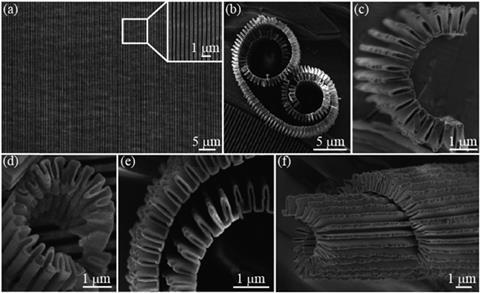Usually brittle films become pliable with a concertinaed microstructure

Scientists in the US have unveiled a conductive and transparent material that also stretches, thanks to its corrugated design. The material’s nano-accordion arrangement demonstrates how microstructure can significantly affect macroproperties, and could find use in flexible electronics, stretchable displays and wearable technologies.
Flexible products are becoming more desirable as smart technologies improve and develop. Many previously discovered conductive materials are opaque and cannot be stretched due to their planar structures. Finding materials that are conductive, stretchable and transparent is therefore of utmost importance to allow these technologies to advance.
Aluminium-doped zinc oxide is transparent and conductive, but very brittle. A flat sheet of this material will break instantaneously when stretched. Now, Chih-Hao Chang and co-workers at North Carolina State University in the US have designed what they see as the ideal solution to this problem and prepared aluminium doped zinc oxide in the shape of an accordion that can be extended and contracted repeatedly without harming the material.
If the geometry is controlled to be very small, a thin film of the material can be put on a stretchable substrate. Team member Abhijeet Bagal recalls that ‘transferring the film onto the stretchable substrate was the most challenging part because it is so small and fragile.’ Chang says that being able to ‘design the accordion geometry with high precision to control the mechanical, optical, and electrical properties,’ will have high technological impact.
Experts in stretchable electronics are enthusiastic about the discovery. Darren Lipomi from the University of California in San Diego, US says, ‘the team were able to create very tall, accordion-like structures using deterministic patterning that permit a level of deformation not possible using other approaches.’ And Zhigang Wu from Uppsala University in Sweden comments that this work ‘may trigger a new wave of technical development of such kinds of applications and accelerate their process of commercialisation.’
It is hoped that future work will integrate the nano-accordions into working devices as well as producing the material on a larger scale.
References
This article is free to access. Download it here:












No comments yet